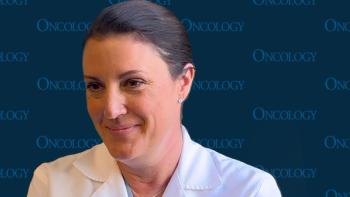
Oncology NEWS International
- Oncology NEWS International Vol 10 No 8
- Volume 10
- Issue 8
Pegfilgrastim Offers Once-Per-Cycle G-CSF Dosing
SAN FRANCISCO-Administering a single dose of pegylated filgrastim (pegfilgrastim) each chemotherapy cycle is as effective as daily doses of filgrastim (Neupogen) in reducing neutropenia among breast cancer patients receiving myelosuppressive chemotherapy, according to two studies presented at the 37th Annual Meeting of the American Society of Clinical Oncology (ASCO).
SAN FRANCISCOAdministering a single dose of pegylated filgrastim (pegfilgrastim) each chemotherapy cycle is as effective as daily doses of filgrastim (Neupogen) in reducing neutropenia among breast cancer patients receiving myelosuppressive chemotherapy, according to two studies presented at the 37th Annual Meeting of the American Society of Clinical Oncology (ASCO).
Both trialsone with pegfilgrastim doses calculated by weight, the other with fixed doses of pegfilgrastimproduced comparable outcomes in patients given the new longer-acting medication and in a control group treated with filgrastim (G-CSF), which is given daily for up to 2 weeks after each chemotherapy cycle.
Although febrile neutropenia occurred in about one in five patients treated with filgrastim in both studies, investigators Frankie Ann Holmes, MD, of US Oncology, Houston, and Michael Green, MD, of Royal Melbourne Hospital, Australia, each reported that it appeared to be somewhat less of a problem in patients who received pegfilgrastim.
"It’s like the new improved Tidea better version of G-CSF," Dr. Holmes told ONI. She predicted that the new drug would be much easier on patients and physicians. "Patients will need only one shot to prevent neutropenia," she said. "In this study, we gave an average of 11 shots to patients on the filgrastim arm."
Amgen, Inc., of Thousand Oaks, California, has submitted a biologics license application for pegfilgrastim to the US Food and Drug Administration (FDA), according to William R.L. Parker, director of product development. "Our intention is to recommend the fixed dose, but obviously that’s up to the FDA," he said.
Dr. Holmes reported that 62 centers enrolled 310 patients for the calculated-dose trial: 156 randomized to filgrastim and 154 to pegfilgrastim. Most were below Medicare age and had not received prior chemotherapy or radiation. All had high-risk stage II/III breast cancer or stage IV breast cancer. They were scheduled to receive four cycles of doxorubicin (60 mg/m2) and docetaxel (Taxotere) (75 mg/m2). The regimen produces a response in 90% of patients, Dr. Holmes noted, but has approximately a 40% incidence of febrile neutropenia.
Patients in the pegfilgrastim arm received 100 µg/kg per 21-day chemotherapy cycle and a daily placebo to maintain the blind in the trial. The control group was given 5 µg/kg of filgrastim daily for up to 14 days. Cytokine therapy was started 24 hours after chemotherapy. In both groups, 92% of patients completed four cycles of treatment, with more than 90% of patients receiving their planned dose on time, Dr. Holmes said.
Study Results
Average duration of severe neutropeniadefined as absolute neutrophil count (ANC) less than 0.5 × 109/Lduring the first cycle of chemotherapy was virtually identical for pegfilgrastim and filgrastim: 1.7 days and 1.6 days, respectively. The incidence of severe neutropenia during cycle 1 was 76% for both groups, but the overall incidence of febrile neutropenia for the pegfilgrastim group was half that of the filgrastim arm: 9% vs 18%, respectively.
Dr. Holmes speculated that the long action of pegfilgrastim provided constant stimulation that made neutropenia less likely and less severe in later cycles. "This chemotherapy regimen produces early and deep neutropenia, but once patients recover, they do not have a second nadir," she said.
Both agents were well tolerated. About one third of patients in both groups had bone pain, which Dr. Holmes categorized as mild.
‘You Can’t Overdose a Patient’
Overshooting with too big a dose is unlikely with the new medication, Dr. Holmes said, because pegfilgrastim is self-regulating. The kidneys wash out filgrastim. In pegfilgrastim, however, a polyethylene glycol (PEG) unit has been bound to filgrastim, creating a larger molecule that is too big for the kidneys to handle.
Instead, the newly formed white blood cells consume the pegfilgrastim, "somewhat like Pac Man," Dr. Holmes quipped, so that by the time the normal white blood cell count has been reached, all of the pegfilgrastim has been consumed. "So you can’t overdose the patient. It’s almost like a thermostat," she said.
Dr. Green used the same protocol, except for delivering a fixed 6-mg dose of pegfilgrastim per 21-day chemotherapy cycle. Conducted in Europe, Australia, and the United States, this trial enrolled 157 patients with stage II-IV breast cancer receiving up to four cycles of the same chemotherapy regimen as in Dr. Holmes’ study.
In cycle 1, the mean duration of grade 4 neutropenia was 1.6 days in the filgrastim group vs 1.8 days in the pegfilgrastim groupa difference of about 4 hours. About 20% of patients in the filgrastim group and 13% in the pegfilgrastim group experienced febrile neutropenia in the study, Dr. Green said.
The median time to absolute neutrophil recovery was 8 days for both groups, he said, and the incidence of severe neutropenia was lower in later cycles. Bone pain was the most frequent cytokine-related toxicity with no difference between the two groups.
Pegfilgrastim, Dr. Green concluded, "has the potential to simplify the management of chemotherapy-induced neutropenia for patients and health care providers."
Articles in this issue
Newsletter
Stay up to date on recent advances in the multidisciplinary approach to cancer.

















































































